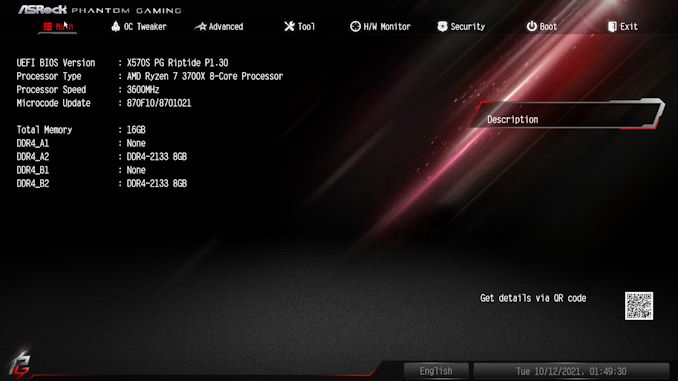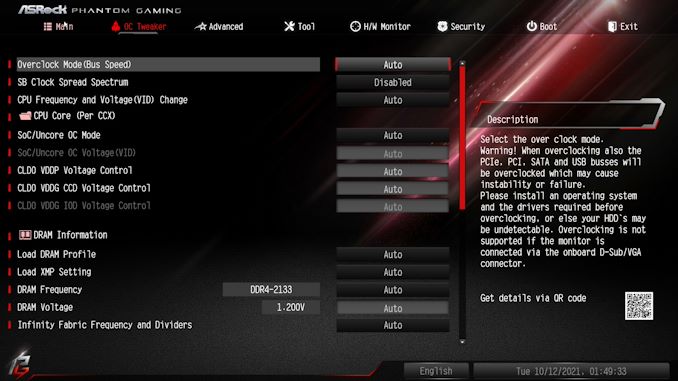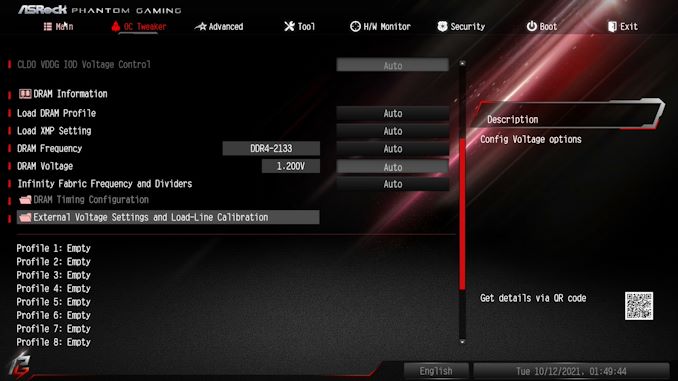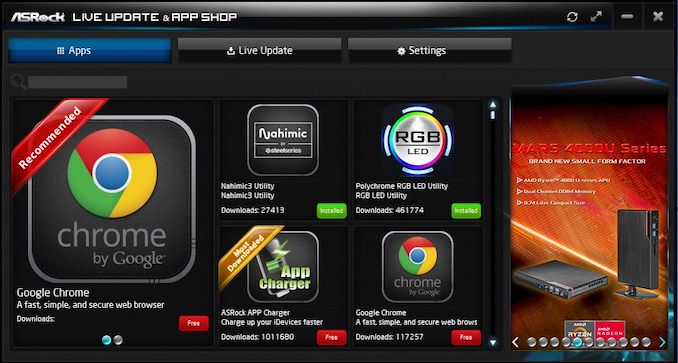The ASRock X570S PG Riptide Motherboard Review: A Wave of PCIe 4.0 Support on A Budget
by Gavin Bonshor on October 22, 2021 9:00 AM ESTBIOS
ASRock is using a consistent and familiar UEFI firmware across its Phantom Gaming series models for AMD's AM4 socket. The GUI consists of a primarily black background with red futuristic highlights, white text, and red highlighting when hovering over an option or menu.
The ASRock X570S PG Riptide UEFI firmware has just one mode which is resemblant of its Advanced modes on models that feature an EZ Mode as well. The main part of the firmware has plenty of menus to select from including (from left to right), the Main screen, the OC Tweaker, the Advanced section, the Tool menu, a H/W Monitor panel, a Security menu, a Boot menu, and an Exit menu.
The area where users can overclock is the OC Tweaker, which has plenty of options for users looking to overclock both the memory and processors. Users with AMD Ryzen APUs can also overclock the integrated Radeon graphics, with the options greyed out on unsupported processors.
There are many options for a budget board such as this in terms of both processor and memory overclocking, although much of it is simplified for users. Users can simply alter the CPU Frequency ratio and CPU VCore voltage and overclock the processor, although there are advanced CPU options such as Loadline Calibration and other voltage options to consider.
Users can also enable X.M.P 2.0 memory profiles on compatible memory kits with a couple of clicks, or alternatively, users can do this manually. ASRock provides lots of latency options for users looking to fine-tune their kits, providing there's any give or take in terms of overclocking. Users can also alter the Infinity Fabric Clock speed (FCLK), with the idea that it operates in a 2:1 ratio to provide the most effective levels of performance. The achievable FCLK varies on the chip, but a memory speed of DDR4-3600 and FCLK of 1800 MHz is seemingly achievable for most and is the sweet spot recommended by AMD.
While the level of customization for a board at this kind of price point lacks in some key areas to what we're used to. There is a basic element of its integrated FAN-Tastic fan tuning utility, but the firmware-based Polychrome RGB utility is lacking any visual expression, instead, users have to use color codes which is abysmal in this day and age. ASRock could be better as previously mentioned, but the rest of the firmware is fine, it's responsive, it's intuitive (aside from the parts mentioned above), and with more customization on the fan control and RGB LED lighting, it would be more than adequate.
Software
Compared to other AM4 boards from ASRock we've covered, the software bundle supplied with the X570S PG Riptide is very basic. The main software applications come via the Live Update and App Shop, with a Restart to UEFI which is a functional piece of software, as well as the Nahimic 3 audio software.
The ASRock Live Update and App Shop allows users to download the latest version of the software that is compatible with the X570S PG Riptide. It also allows users to download up-to-date drivers for the board including controller drivers such as networking, as well as AMD's latest chipset drivers at the click of a button.
Unfortunately, the ASRock X570S PG Riptide doesn't come supplied with any overclocking software such as A-Tuning or the Phantom Gaming series variant. Users looking to access overclocking tools within Windows can easily download the AMD Ryzen Master tuning utility, which we've used with great success previously and is very intuitive and easy to use. ASRock does include Nahamic too which is designed to enhance a user's auditory experience, and the Restart to UEFI software is also useful for directly booting into the firmware at the click of a button.
Overall it's not a feature-packed software bundle, but it's adequate and we still believe ASRock could have shipped one of its own overclocking software with this board.


























39 Comments
View All Comments
Threska - Sunday, October 24, 2021 - link
Nothing says "canary" as a precursor to the fall of society as the decline of social skills. Soon we all will be communicating in the language of "road-rage".Spunjji - Monday, October 25, 2021 - link
I certainly think education on critical thinking would be of use, but I'm not so sure about fallacies specifically - your example is instructive here, as when lawyers use fallacies, they tend to do so in full knowledge of what they're doing. The target audience are likely to assess the information according to their priors - knowing that they've been presented with a fallacy is unlikely to sway them if they happen to agree with the conclusion.We saw this recently in the UK with a court decision (now overturned) that barred prescribing puberty blockers to trans children on the basis of an assumption that correlation entails causality; whenever this was pointed out people tended to respond by insisting that it was still the right decision for some other (usually unproven or false) reason.
Education on critical thinking is sorely lacking. I didn't get a grounding in subjects like formal logic and epistemology until I studied Philosophy as an undergraduate (I'm in the UK and was educated in a state school, for context).
Oxford Guy - Friday, October 29, 2021 - link
Enough education on fallacies would, hopefully, get them removed from serious discourse. The audience of lawyers is not only the highly-educated. Also, even those with advanced degrees are often only given cursory training in fallacies. The cram-then-forget style of so much of higher education is part of the problem. There is also pressure on all people in a society dominated by fallacies to cave.‘Critical thinking’ should also be reframed as ‘true thinking’ or similar — to remove the false implication that ‘critical’ thinking is special (therefore optional/compartmentalized) rather than the only kind of thinking that yields accurate understanding.
Another massive problem is bad terminology, terminology that so often enables people to avoid the rigor of rationality. When people hear of ‘critical thinking’ they are inclined to believe it’s an academic exercise rather than the way thinking should be approach generally. The embedded word critic also implies combativeness, an excessively-judgmental mentality. Given the strong appeal of conformity (i.e. being ‘chill’), such connotations are counterproductive.
opinali - Saturday, October 23, 2021 - link
The problem with this idea is the economics. If we make the Cartesian product of all CPU models even within a class, all motherboard models, RAM and SSD capacities, plus other variants that exist already (high-end Ethernet or not etc.), that's a truckload of possible SKUs. Unless you pick a one size fits all choice.TheinsanegamerN - Saturday, October 23, 2021 - link
I've got a better idea, what if we made a stqandard that would allow people to put in what they want/need at a price they are comfortable with? Oh hey, we already have that!If you want non upgradeable e-waste, and putting a CPU in a mobo is that hard for you, apple is already available for you. What would soldering everything even gain for you, outside of making everything permanent?
Oxford Guy - Saturday, October 23, 2021 - link
What has been needed for many many years is a change from the ATX form factor to one that cools GPUs efficiently.It has long been utterly ridiculous that the highest-power item in a machine spews its heat back into the case and has tiny fans to cool it.
Threska - Sunday, October 24, 2021 - link
There's change out there. Just not in the market most play in.https://youtu.be/chNM_nntwKU
Spunjji - Monday, October 25, 2021 - link
Yeah, this situation is bizarre. We're long overdue for a substantial change to system form-factor.Calin - Monday, October 25, 2021 - link
Intel introduced BTX 20 or so years ago.There is the ITX, miniITX, MicroATX, all the "small form factors", Intel's "Next Unit of Computing" (NUC), and so on and so forth.
I remember BTX being intended to support better cooling - but for that you have the cases with rotated mainboard, ports on top, multiple chambers (PSU separated from the rest), ...
Not to mention the fact that laptops are taking over desktops (with multiple form factors, from 13" and under laptops to 17.3" gaming rigs or engineering workhorses)...
A system form factor change is taking place...
Oxford Guy - Friday, October 29, 2021 - link
I was aware of BTX but don’t recall that it was mainly about getting GPU waste heat under better control. Perhaps it was. It has been a long time. AMD, Silverstone, Apple have also introduced other form factors. Regardless, the ATX form factor has remained dominant for far far too long.